Born in Aichi Prefecture in 1996, Hotaru Shiro moved to Tokyo in 2019 to start her career as an artist. In March of this year, she held her first solo exhibition at Gallery Camellia in Ginza, curated by Maiko Yamashita. We talked to her about her activities, focusing on her works and production, as she creates works consisting of painted canvases with the stance of "cutting out momentary stories" and frames that she calls "sculptures".
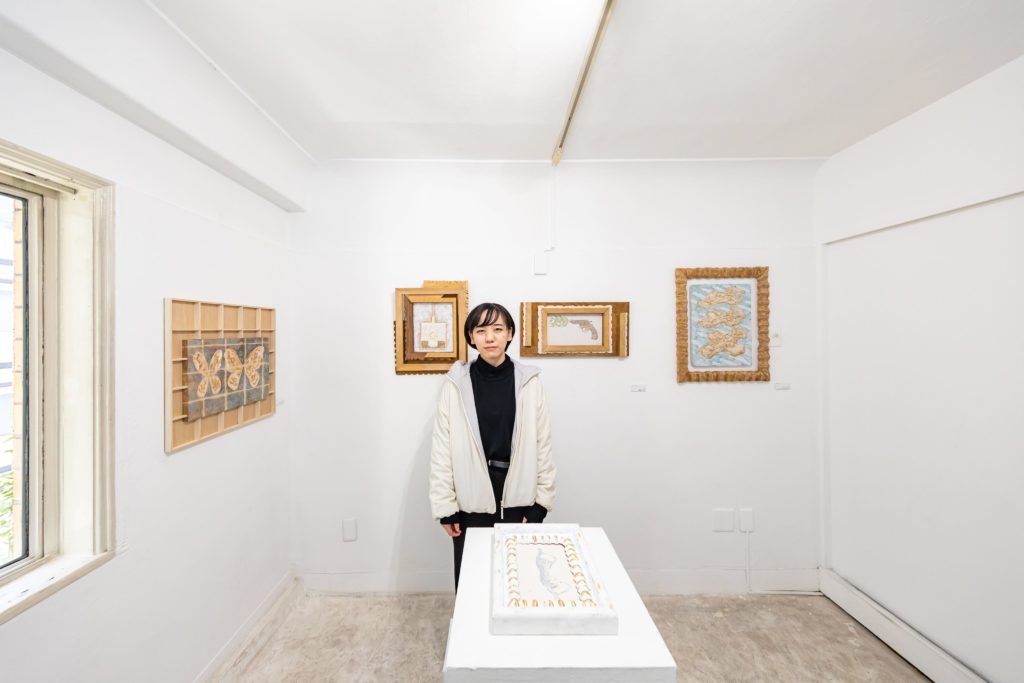
I'd like to ask you about the external appearance of your works. Some of your works are divided into paintings and frames, while others are not. You yourself call the frame part "sculpture" and separate it from the frame as decoration. What I would like to ask is what is the position of this part of the wooden frame in Mr. Shiro's work.
-In general, a picture frame has a strong connotation of a decorative object. It stands as a decoration for the painting. For me, I don't have a sense that I'm creating a separate existence for the painting and the frame. It's not like I'm painting a picture and putting a handmade frame on it. If I set it up as a frame, it would sound like a decoration for the painting, but it's not there for the painting. It is not that one of them plays the leading role and the other the supporting role.
I think it is difficult to distinguish between two-dimensional and three-dimensional works. Are you aware of this?
-I don't think I'm limiting myself when it comes to whether or not my work is two-dimensional. One of my earliest works in this form was "The Old Man and the Sea III", which was created by cutting out a moment in the story, and I used a frame to preserve that moment. In the first place, picture frames are used to preserve important photographs and memories. But the wooden frame is not a decoration for the picture, so I don't think of it as a flat surface or as the main part of the picture. On the other hand, it's not a three-dimensional work either. So it's neither, and it's difficult to separate them. I don't think it's necessary.
There are artists who try to stand on the borderline between two-dimensional and three-dimensional works, such as Richard Tuttle, for example, or recently in Japan, Takanosuke Yasui. Do you also have this awareness?
-No, I wasn't particularly conscious of it. At the very beginning, I didn't like the squareness of the canvas. I was sick of having a fixed shape. If it was just a picture, it would have corners and sides, and if it was paper, it would have the thickness of the paper, but those things bothered me. It bothers me a lot. If I'm going to put a nail in the side of a canvas, I definitely want to hide it. It looks like it's in the way and there's nothing I can do about it. I'm a person who thinks like that, but when I wasn't in Tokyo yet, the shape of the canvas really bothered me when I was working. I think he was uncomfortable with it. So I decided to go outside and start with a square canvas. At first, it was more of a momentum thing, something like, "Let's do it.
I arrived at the frame as a means of "sticking out. Was it an accident?
-No, the logic was there. So... I think it's a little different than accidental. I thought it would be more expansive if I did.
There are various precedents for expressive methods that modify the canvas into a form, such as tearing, cutting, and burning the canvas. One of the most interesting points is the progress made to the periphery of the painting.
-I didn't want to do anything violent to the surface of the painting. I didn't want to scratch it.
 The Old Man and the Sea III
The Old Man and the Sea III
oil/water-dry paint/mixed media on canvas, 52 x 42 cm, 2019, private collection
What was the first work you created with the idea of "off the canvas" in mind?
-In terms of consciousness, I'd say "The Old Man and the Sea III". It was a work that made many things clear. But that's not where my direction was born. There were other works (using wooden frames) before that. So... I guess it was more like a discovery. Things that I had been doing unconsciously, that I hadn't even noticed before, came to me and I thought, "So that's what I've been doing. Now I feel like I'm adjusting the way I do things.
For example, "Whale and Wave" is a circular work without a frame. You mentioned earlier that you have a "way of creating that cuts out the story." In other words, do you have a moment or motif of the story that you want to make into a work of art first, and then in the process of practicing it, you may or may not need to differentiate between the painting and the frame?
-Yes, that's right. So it depends (on whether you use frames or not). If I use them, I think it is inevitable. But there are works that do not. It's not that the work can't be completed without them, but it's a way of employing them when necessary. In the case of "Whale and Wave," there was no necessity for it to appear, and it went the other way, or rather, the support went in a round shape. It was the most natural thing for the work. The work would have been complete without it. The frame is there only because it is a natural form for the work.
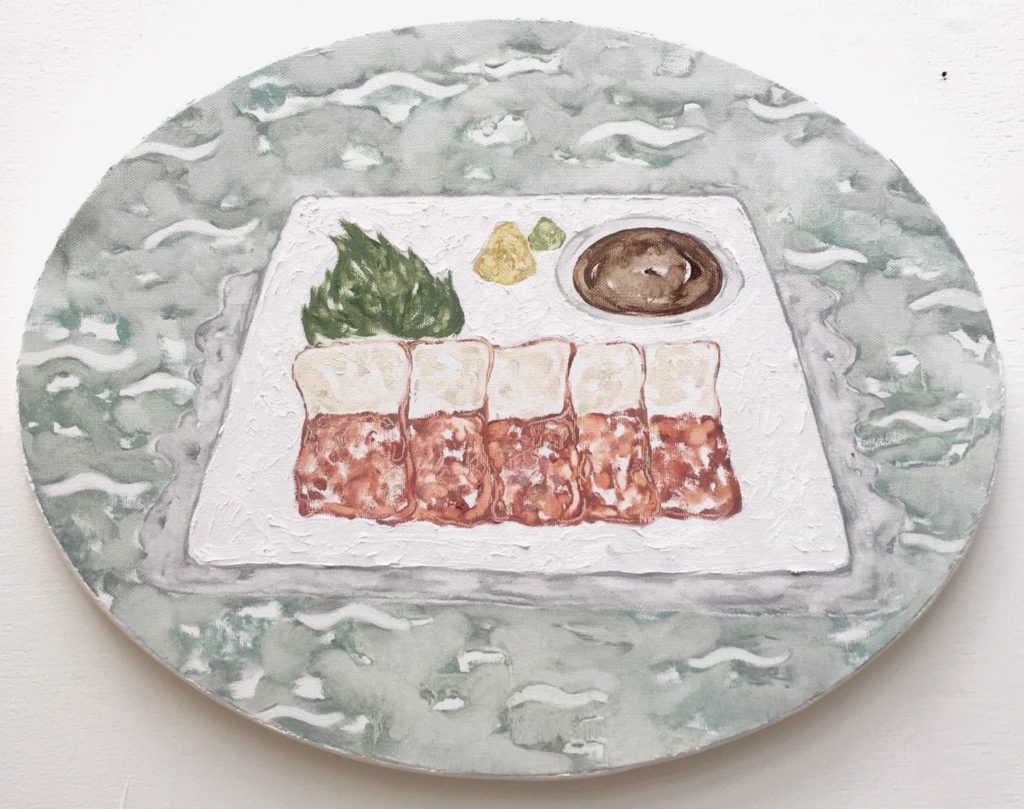 Whales and Waves
Whales and Waves
oil/water-dry paint/mixed media on canvas, 35×45, 2019, private collection
So the frame is just an extension of the expression. There is a story, there is a painting, and in some cases there is a frame and a deformable support.
-Yes, so anyway, for me there is no reason to take them separately. So anyway, for me there is no reason to take them separately, because they are both connected by a single expression. And whether there is a frame or not, what I am doing is the same. Like "Whales and Waves," for example, there are works that depict creatures that have been transformed by human hands, or landscapes or places where they used to live. I think that such works should have a frame. So, it depends.
Moving on from form to content, does the story you mentioned earlier have a time axis like a movie or novel? Is there a time axis like in a movie or novel?
-The motif comes first. I have a subject that I want to depict, and then I find out what kind of people are around it, and the people and places involved. With the object as the axis, I think about the scenery that the people who see it see, the scenes they remember, and the inside of their brains. As a result, I am cutting out a story or time, but the motif comes first. It's more like a momentary narrative. It's a momentary story, like 10 seconds or 10 minutes of the people who appear. I'm not thinking about a lifetime.
It sounds like you are focusing on the memories of the characters.
-Not necessarily on people, but memories might be. That's why we might think about the scenery the creatures in the story saw, the people they met, the conversations they had in the past, or the places they existed in the past. The first time I used a picture frame in the first place, it was also associated with memories and recollections.
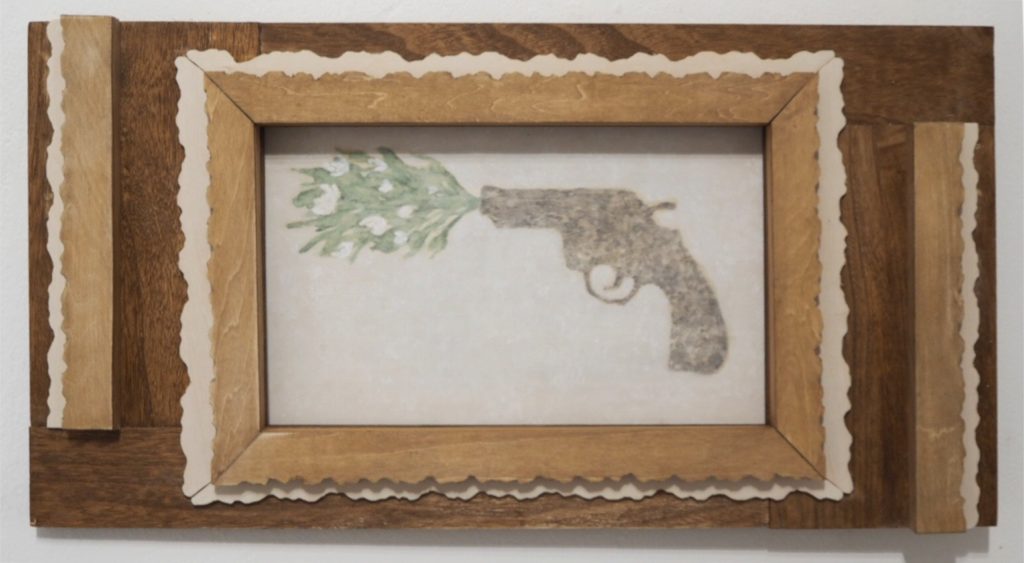 Yasashii Sekai
Yasashii Sekai
oil/water dry paint/wood on board, 30.5 x 61 x 5.5cm, 2020, private collection
Assuming that you are focusing on memory, what is the source of the motif? Are they completely imaginary or do you draw from your surroundings?
-It's almost like the motifs come from the other side, but I don't know, I make notes. I don't know, but I make notes. I write down things that I see in my daily life, things that catch my attention. I write down things that I see in my life, things that catch my attention, things that I think, "Oh, I want to draw this. I collect fragments, and there are certain things that I have a habit of doing, such as car headlights and clay figurines, which basically appear as the main motif in my works.
In terms of narrative form, for example, novels can be written in first, second, or third person, but what is your point of view when you create?
-Maybe it's the point of view of the motif. So I think third person is closer. It includes my own thoughts, but the closest thing is the motif. I also think about the motif, what the third person thinks, the weather, and humidity. I wonder where the motif is or was, and what the surrounding environment is like. For example, if the motif of the work is a clay figurine, I think about the people who made the figurine in the past, or the owner who spent a long time with it. I think about all the people who are there.
 Luminous Insect
Luminous Insect
oil/water-dry paint/mixed media on panel, 53×53cm, 2020
When you talked about your notes, you said that you write down "things that you want to paint", is there anything in common there? What do your works have in common? Do the motifs and materials you choose have anything to do with the world view you are aiming for?
-Basically, I draw what I want to draw, but there are definitely similarities. It can be dark, a little scary, mysterious, poisonous, or creepy. There are also bright spots, though. But I think it's more like I'm trying to purify them in my work. I don't use black now, probably because it doesn't balance well. If I use it, I end up painting in a darker way. I think that's a little different. I think it's okay to have brightness even if darkness is at the root. Maybe I have a strong desire to make it clean.
Negative purification.
-Yes, that's close. Fundamentally, it's my own, and superficially, it's for others. I think it's the making of the work itself, or rather the leaving of the moment that is the purification. Whether it's myself or someone else, I think it's purifying to project it through my own filter as a work of art. That's why I use white colors. I feel more relaxed that way.
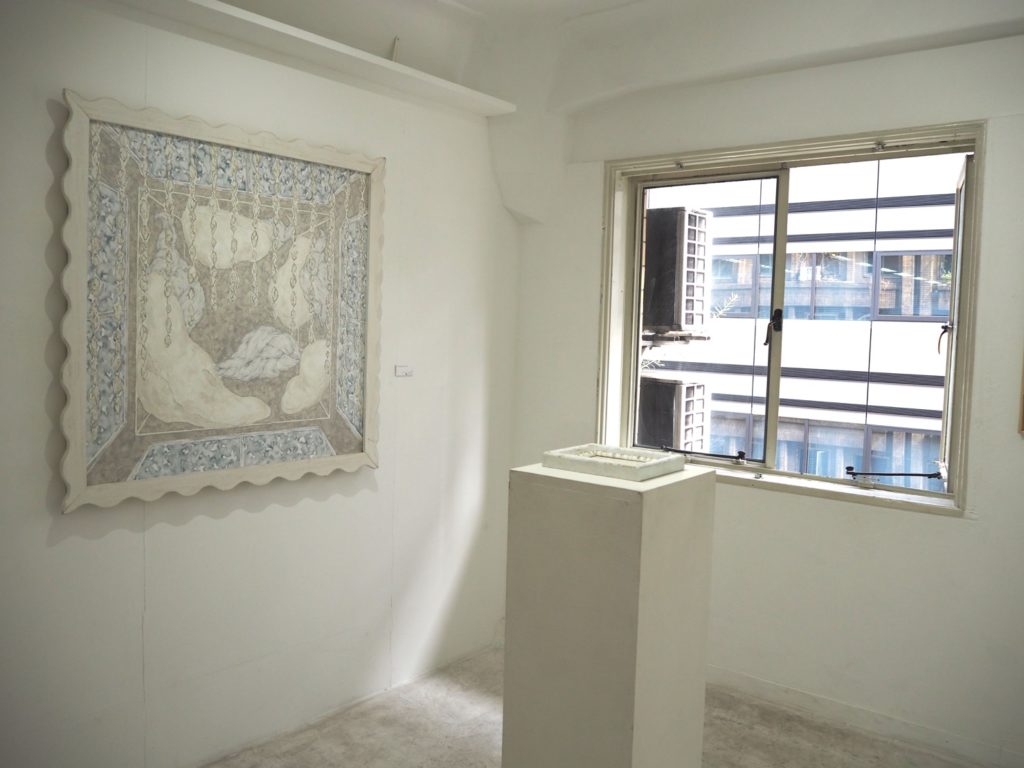 Installation view from solo-exhibition at Gallery Camellia, 2020
Installation view from solo-exhibition at Gallery Camellia, 2020
I would like to extend the discussion to your background.
-I don't know. Schiele, Bonnard, Dumas, Peyton, Wyeth, and then there's Kyoko Murase and Chris Huynh-Sing Kang, Hammerschmidt, and an infinite number of others, but I'm not sure how close they are. I like them, but I don't think they are the same. I don't think they are often the works I should be painting. But Hamashoi, yes, because it's so uncomfortable. ...... A teacher at my prep school said, "The appeal of Hammershoi is the sense of discomfort," and I remember that phrase when I feel that something is missing in my work.
There are many contemporary painters, but were you always interested in contemporary art?
-Not really. I majored in oil painting in high school, but what I learned there was traditional oil painting. It was a school where there was a lot of technical talk about how to paint. That was when I was still a student. I fell in love with it when I was studying how my current works were formed.
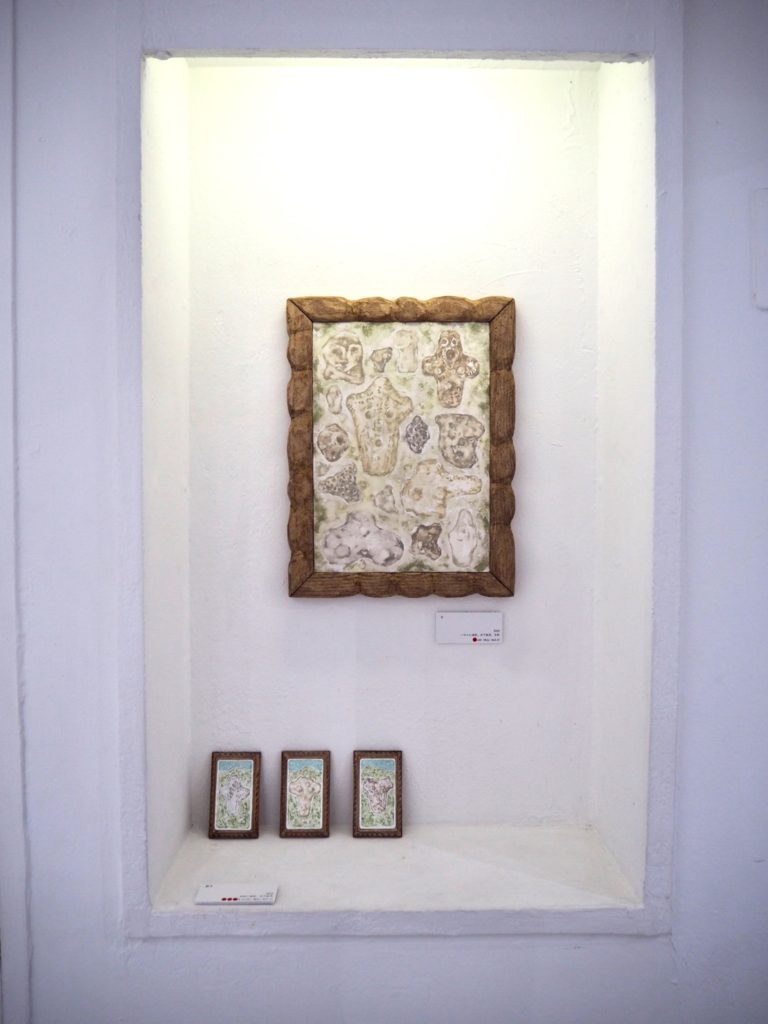 Installation view from solo-exhibition at Gallery Camellia, 2020
Installation view from solo-exhibition at Gallery Camellia, 2020
This is a little off topic, but you moved from Aichi to Tokyo and started your activities. This is your second year in Tokyo. What made you come to Tokyo in the first place?
-It's simply a matter of motivation. I didn't go to art school, but after two years of wandering, I decided to continue making art in a small way. I quit my prep school and worked part-time to make ends meet, but to be honest I didn't draw much during that time. ...... I think I did about two or three pictures a year. I would work, go home, and get tired. It was during this period that I was approached by the artist Atsuko Yamashita. He said, "If you want to continue, Tokyo is a better place. Come to Tokyo. I think that was the right decision. The environment is completely different, and the information that comes in is completely different.
In some respects, contemporary art is a strategic world. Shiro-san's first solo exhibition was held in the second year after he moved to Tokyo. It was curated by Maiko Yamauchi. You are off to a very good start, but do you think about your positioning?
-I don't know, I don't really think about positioning. I don't know, I don't really think about it much, maybe I'm just not sure yet. But there are certain works that I like, and I think it's good to have works that the artist truly enjoys, as well as when you look at them. I want to make that kind of work. The rest of the time, I only think about the work. But I don't know what's going to happen in the future, because my feelings have a big impact on my work.
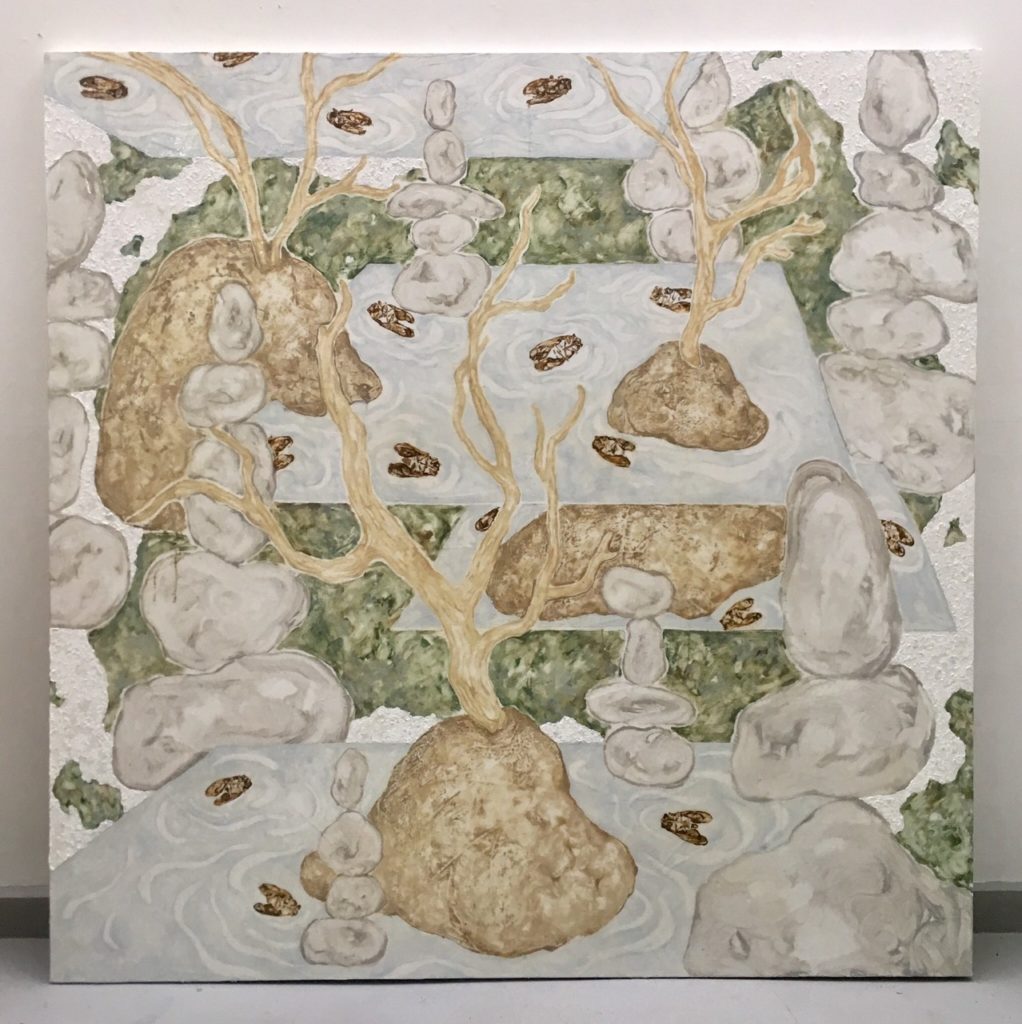 Natsuhate
Natsuhate
oil/water dry paint/resin on canvas, 162 x 162cm, 2019
Will your works change more? For example, will you stop using frames at all?
-maybe, maybe not. I don't even consider myself a painter in the first place. So I don't intend to limit my work to paintings. But that doesn't mean I'm a sculptor either. In the future, I'm thinking of various directions for my work, such as using the same support (without separating the canvas from the frame) or increasing the thickness of the canvas, but I have no intention of stopping painting or painting itself. ...... I think I do draw pictures. But I don't know how I do it. At the moment.
Click here to go to TRiCERA page